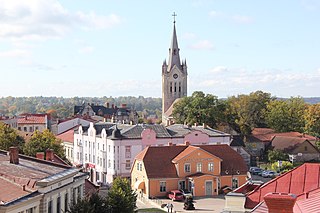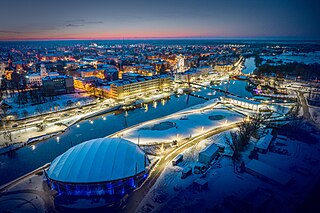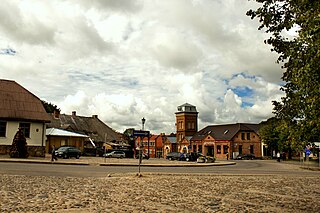
The history of Latvia began around 9000 BC with the end of the last glacial period in northern Europe. Ancient Baltic peoples arrived in the area during the second millennium BC, and four distinct tribal realms in Latvia's territory were identifiable towards the end of the first millennium AD. Latvia's principal river Daugava, was at the head of an important trade route from the Baltic region through Russia into southern Europe and the Middle East that was used by the Vikings and later Nordic and German traders.

Riga is the capital, the primate, and the largest city of Latvia. Home to 605,273 inhabitants, the city accounts for a third of Latvia's total population. The population of Riga metropolitan area, which stretches beyond the city limits, is estimated at 860,142. The city lies on the Gulf of Riga at the mouth of the Daugava river where it meets the Baltic Sea. Riga's territory covers 307.17 km2 (118.60 sq mi) and lies 1–10 m (3–33 ft) above sea level on a flat and sandy plain.

Cēsis, is a town in Latvia located in the northern part of the Central Vidzeme Upland. Cēsis is on the Gauja River valley, and is built on a series of ridges above the river, overlooking the woods below. Cēsis was selected to be one of the candidate cities for the title of the European Capital of Culture 2014.

Tukums is a town in Latvia and serves as the administrative center of Tukums Municipality. It is located in the eastern part of the historical region of Courland, and with more than 16,000 inhabitants Tukums is the 13th largest settlement in Latvia. It is also an important railroad junction, connecting the town with Riga, Jelgava and Ventspils. It has two railway stations — Tukums I and Tukums II.

Kuldīga is a town in the Courland region of Latvia, in the western part of the country. It is the center of Kuldīga Municipality with a population of approximately 13,500.

The Livonians, or Livs, are a Balto-Finnic people indigenous to northern and northwestern Latvia. Livonians historically spoke Livonian, a Uralic language closely related to Estonian and Finnish. Initially, the last person to have learned and spoken Livonian as a mother tongue, Grizelda Kristiņa, died in 2013, making Livonian an extinct language. In 2020, it was reported that newborn Kuldi Medne had once again become the only living person who speaks Livonian as their first language. As of 2010, there were approximately 30 people who had learned it as a second language.

Jelgava is a state city in central Latvia. It is located about 41 kilometres southwest of Riga. It is the largest town in the Semigallia region of Latvia. Jelgava was the capital of the united Duchy of Courland and Semigallia (1578–1795) and was the administrative center of the Courland Governorate (1795–1918).

Bauska is a town in its eponymous municipality, found in the Zemgale region of southern Latvia.

Semigallia is one of the Historical Latvian Lands located to the south of the Daugava and to the north of the Saule region of Samogitia. The territory is split between Latvia and Lithuania, previously inhabited by the Semigallian Baltic tribe. They are noted for their long resistance (1219–1290) against the German crusaders and Teutonic Knights during the Northern Crusades. Semigallians had close linguistic and cultural ties with Samogitians.

Limbaži is a town in the Vidzeme region of northern Latvia, with a population of 6,888. Limbaži is located 90 km northeast of the capital Riga. During the Middle Ages, as part of Livonia, Limbaži was a fortified town with stone walls, second in importance only to Riga.

The ArajsKommando, led by SS commander and Nazi collaborator Viktors Arājs, was a unit of Latvian Auxiliary Police subordinated to the German Sicherheitsdienst (SD). It was a notorious killing unit during the Holocaust.

Koknese is a town in Aizkraukle Municipality in the Vidzeme region of Latvia, on the right bank of the Daugava River. It has a population of nearly 3,000.

Cesvaine is a town in Madona Municipality, Vidzeme Region, Latvia. It is home to the Cesvaine Palace, built in 1896 near the ruins of previous medieval castles.

Ikšķile is a town in Ogre Municipality, in the Vidzeme region of Latvia. It was the first capital of the Roman Catholic Bishopric of Livonia, known by the German name of Üxküll. Saint Meinhard was the first bishop of Üxküll. In 1197, Berthold of Hanover, a Cistercian abbot of Loccum, was made the second bishop of Üxküll. Those days the town was the center of the upcoming crusading activities in the Livonian area. Bishop Berthold moved the episcopal see to Riga, before being killed by the Livs in battle.

The Livonian crusade consists of the various military Christianisation campaigns in medieval Livonia – modern Latvia and Estonia – during the Papal-sanctioned Northern Crusades in the 12th–13th century.

Kandava is a town in Tukums Municipality, in the Courland region of Latvia. It had a population of 3,656 people as of January 2020.

The history of Riga, the capital of Latvia, begins as early as the 2nd century with a settlement, the Duna urbs, at a natural harbor not far upriver from the mouth of the Daugava River. Later settled by Livs and Kurs, it was already an established trade center in the early Middle Ages along the Dvina-Dnieper trade route to Byzantium. Christianity had come to Latvia as early as the 9th century, but it was the arrival of the Crusades at the end of the 12th century which brought the Germans and forcible conversion to Christianity; the German hegemony instituted over the Baltics lasted until independence—and is still preserved today in Riga's Jugendstil architecture.

Salaspils camp was established at the end of 1941 at a point 18 km (11 mi) southeast of Riga (Latvia), in Salaspils. The Nazi bureaucracy drew distinctions between different types of camps. Officially, it was the Salaspils Police Prison and Re-Education Through Labor Camp. It was also known as camp Kurtenhof after the German name for the city of Salaspils.

Lielvārde Castle is a castle in Lielvārde, a town in Ogre Municipality in the Vidzeme region of Latvia.The castle was built at the steep bank of Daugava River, overseeing this important medieval waterway, before 1248 by Albert of Buxthoeven, an archbishop of Riga. During the Livonian War, Lielvārde Castle was destroyed by Russian troops in 1579. Its ruins are conserved up to the level of the second floor.

Ako was a Livonian ruler and elder of Livonian Daugava from modern-day Salaspils who fought during the Livonian Crusade against the German crusaders and the Livonian Brothers of the Sword in the beginning of the 13th century. In June 4, 1206, Ako died during the Battle of Salaspils, and as a result of the death, his head was brought to Riga for Albert of Riga as a sign of victory against Ako.



























